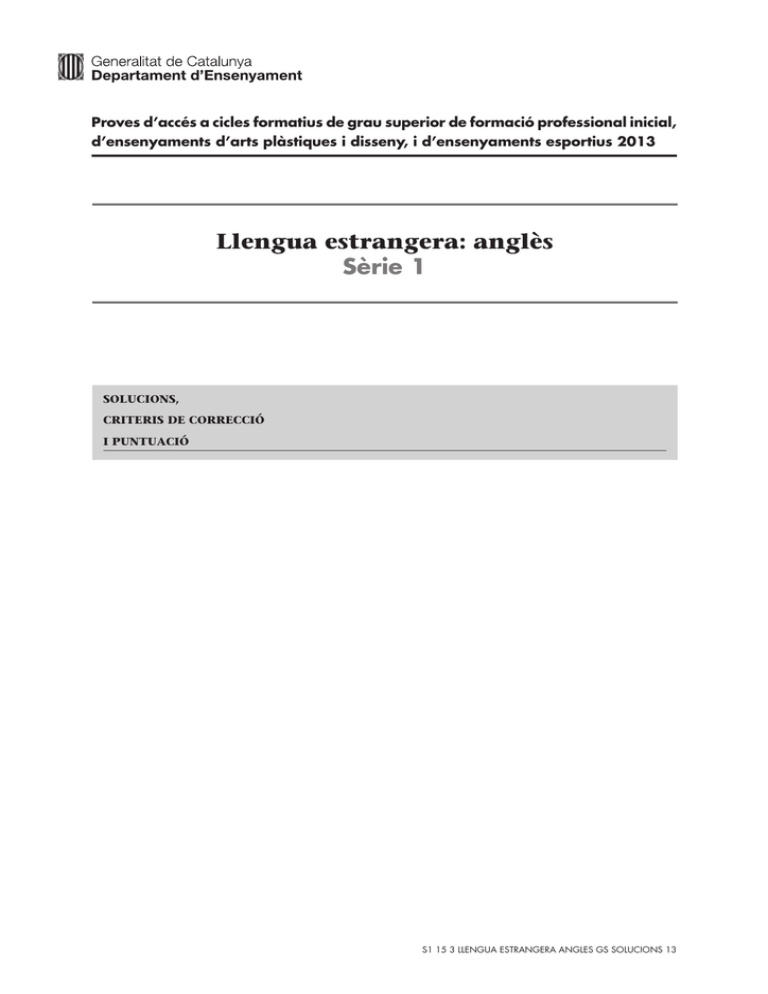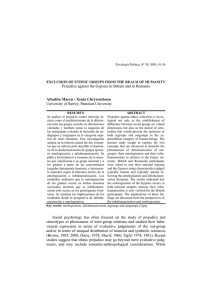Solució - Institut Milà i Fontanals
Anuncio

Proves d’accés a cicles formatius de grau superior de formació professional inicial, d’ensenyaments d’arts plàstiques i disseny, i d’ensenyaments esportius 2013 Llengua estrangera: anglès Sèrie 1 SOLUCIONS, CRITERIS DE CORRECCIÓ I PUNTUACIÓ S1 15 3 LLENGUA ESTRANGERA ANGLES GS SOLUCIONS 13 A. Read the text below and choose the correct answer. [1.25 marks: 0.25 for each correct answer] 5 10 15 20 25 GYPSIES In parts of Europe they are still seen as annoying foreigners or treated as exotic people, but Gypsies have ancient roots that go back more than a millennium. A genetic analysis of 13 Gypsy groups around Europe has revealed that the arrival on the continent of their ancestors from northern India happened earlier than was thought, about 1,500 years ago. The earliest population reached the Balkans, while their expansion from there came nine centuries ago. They arrived in one single wave from the north-west of India around 1,500 years ago. Gypsies were originally thought to have come from Egypt and some of the earliest references to them in English, dating back to the 16th century, call them “Egyptians”. They arrived in Europe in the sixth century—a time when Britain was still in its early post-Roman era. They arrived in Spain in the 15th century or earlier—with records* of groups of up to a hundred Gypsies travelling together, often led by someone who called himself a “count” or “duke—and stayed, although the authorities tried hard to expel them or imprison those who refused to give up their language and culture. Gypsies, often referred to as Roma, are found across all of Europe and make up the continent’s largest ethnic minority. There are about 11 million Gypsies in Europe. Centuries of discrimination, including systematic extermination by some 20th-century fascist regimes, have helped keep many of them marginalized. Both France, during Nicolas Sarkozy’s presidency, and Italy, under Silvio Berlusconi, targeted Gypsy communities with populist eviction policies, while discrimination continues in much of Eastern Europe. But the stereotypical wandering Gypsy belongs to the distant past. Most Europe’s Gypsies have long been sedentary. In addition, it seems that Gypsies not only share common ancestry from north-west India, but also that they have mixed extensively with other Europeans. That is more pronounced in Northern and Western Europe, where they conserve the genetic footprint from India, but their ancestors are both European and Indian. Text adapted from an article by Giles TREMLETT, The Guardian. (7 December 2012). *record: document, registre / documento, registro. 1. In some parts of Europe Gypsies a) are seen as interesting but different from the rest. b) are considered as the authentic Europeans. c) have been present since the first century. 2. Until recently it was believed that Gypsies a) arrived in Europe in groups of thirteen members. b) came directly from the Balkans c) came to Europe later than they actually did. 2 3. Gypsies arriving in Spain a) were offered help by the nobility. b) were asked to abandon some of their traditions. c) were systematically sent to prison. 4. Gypsies a) are one of the most numerous ethnic minorities outside Europe. b) are the ethnic minority in Europe with the most members. c) are an ethnic minority composed of 11 million members in total. 5. At a) b) c) present, Gypsies living in Europe are exactly like the Gypsies that first arrived in Europe. are 50 % Indian and 50 % European. have both European and Indian genes. Pregunta Resposta Text de referència 1 a 1st paragraph: "In parts of Europe they are still seen as annoying foreigners or treated as exotic people […]" c 2nd paragraph: "A genetic analysis of 13 Gypsy groups around Europe has revealed that the arrival on the continent of their ancestors from northern India happened earlier than was thought, about 1,500 years ago" b 5th paragraph: "And stayed, although the authorities tried hard to expel them or imprison those who refused to give up their language and culture" b 6th paragraph: "Gypsies, often referred to as Roma, are found across all of Europe and make up the continent’s largest ethnic minority. There are about 11 million Gypsies in Europe" c 10th and 11th paragraph: "In addition, it seems that Gypsies not only share common ancestry from north-west India, but also that they have mixed extensively with other Europeans. That is more pronounced in Northern and Western Europe, where they conserve the genetic footprint from India, but their ancestors are both European and Indian" 2 3 4 5 3 B. Choose the word or definition (a, b, c, or d ) that best explains the meaning of the words below as they are used in the text. The words appear in bold type in the text. [1.25 marks: 0.25 for each correct answer] La solució correcta està destacada en lletra negreta. 1. roots a) origins b) grounds c) legends d) contexts b) arrived in c) discovered d) colonized b) movement c) invasion d) scroll b) to transport c) to destroy d) to send away b) organizations c) plans d) attacks 2. reached a) landed 3. wave a) committee 4. to expel a) to convert 5. policies a) armies 4 C. Read the text below and choose the correct answer. [2.50 marks: 0.25 for each correct answer] DANGEROUS ENCOUNTERS Although cougar attacks are ___(1)___ rare in North America, they are steadily increasing. In the 1990’s, there were thirty-six recorded attacks, seven of ___(2)___ were fatal, compared with twenty including two fatal in the 1980’s, and out of seventeen attacks four were fatal in the 1970’s. Sadly, in January 2001, a woman cross-country skier ___(3)___ and killed by a cougar in the ski resort of Banff, Canada. The cougar ___(4)___ behind a tree near the trail and jumped ___(5)___ Frances Frost, thirty, ___(6)___ she passed, killing her. The cat was later killed by park wardens. Ian Syme, chief warden of the Banff National Park in the Rocky Mountains, ___(7)___ that cougars rarely attack human beings. ___(8)___, he recommends that if you want to go skiing or hiking in the mountain wilderness, you ___(9)___ travel in a group and leave dogs at home because they attract cougars. Other wildlife experts ___(10)___ add that it is important to make plenty of noise to reduce your chances of surprising a lion and carry a sturdy walking stick to ward off an attack. Make sure small children stay within sight and never approach a lion, especially if feeding or with kittens. La solució correcta està destacada en lletra negreta. 1. a) yet b) already c) still d) ever 2. a) which b) whom c) whose d) what 3. a) was chased b) were chased c) had chased d) chased 4. a) had been hidden b) was going to hid c) has hidden d) had hidden 5. a) into b) on c) across d) out of 6. a) during b) meanwhile c) as d) whenever 7. a) spoke b) said c) told d) talked 8. a) Although b) However c) But d) On the contrary 9. a) would b) should c) need d) may b) also c) too d) both 10. a) as well 5 D. Write 80-100 words about ONE of the following topics. [5 marks] 1. Imagine you are a young man/woman who has just arrived in a new country. Write a diary entry saying how you feel about the new place and how different it is from where you used to live. 2. Write an email to a friend telling him/her about a typical celebration/tradition of your culture. Tell him/her why it is important and what people do during this celebration/ tradition. Valoreu l’exercici globalment de 0 a 5 punts segons els criteris següents: 5 punts Molt bon resultat Text coherent, amb cohesió i ben puntuat en el qual s’utilitzen de manera correcta estructures gramaticals complexes i variades. El vocabulari és adequat al registre del text i no es repeteix. Hi ha molt poques errades ortogràfiques, lèxiques o gramaticals i no dificulten, en cap cas, la comprensió del text 4 punts Bon resultat Text coherent, amb cohesió i ben puntuat en el qual s’utilitzen de manera correcta estructures gramaticals simples però variades. El vocabulari és adequat al registre del text i no es repeteix. Hi ha algunes errades ortogràfiques, lèxiques o gramaticals que no dificulten la comprensió del text 3 punts Resultat adequat Text coherent, amb cohesió i ben puntuat en el qual s’utilitzen estructures gramaticals simples i vocabulari senzill però variat i adequat al registre del text. Hi ha errades ortogràfiques, lèxiques o gramaticals que no dificulten la comprensió del text en la major part dels casos 2 punts Resultat inadequat Text poc coherent, amb poca cohesió i manca de puntuació en el qual s’utilitzen estructures gramaticals i vocabulari pobres i repetitius. Hi ha nombroses errades ortogràfiques, lèxiques o gramaticals que dificulten la comprensió del text 1 punt Resultat pobre Text gens coherent, sense cohesió ni puntuació correcta. El text és difícil d’entendre a causa de les nombroses errades ortogràfiques, lèxiques o gramaticals 0 punts Mal resultat Text que no s’adequa a l’opció escollida i la comprensió del qual és molt difícil o impossible Descompteu 0,5 punts si el text redactat no té la llargària mínima demanada. 6 7 L’Institut d’Estudis Catalans ha tingut cura de la correcció lingüística i de l’edició d’aquesta prova d’accés
